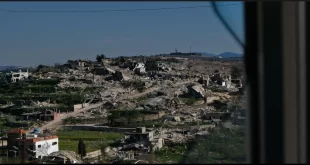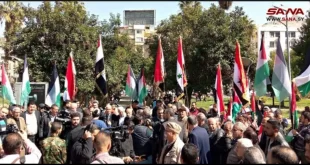Palestine Correspondent, The Cradle, July 6, 2022
The Axis of Resistance is solidly grounded in Damascus while decisions must be made on how to deal with Hamas’ betrayal of their benefactors in Syria when their identity with Muslim Brotherhood was deemed more important than Syrian leadership in support of Palestine. A deep wound remains. [ed]
On 21 June, two unnamed Hamas sources told Reuters that the Palestinian resistance movement had decided to restore ties with Damascus following a decade-long rift after Hamas expressed support for the Syrian opposition.
The news caused a row, and it seems that this may have been the purpose behind its leak.
Shortly after the report, dozens of websites, satellite channels and media commentators in Turkey, Qatar, and the UK who are sympathetic to the Muslim Brotherhood – the political Islamist group to which Hamas belongs ideologically – distanced themselves from Hamas, which has neither confirmed nor denied the reports.
However, comments made by the head of the Political Bureau of Hamas, Ismail Haniyeh, has added credence to these claims.
In a speech before the National Islamic Conference in Beirut, on 25 June, Haniyeh said, “The time has come after ten years to make historic reconciliations in the Islamic nation.”
“What is happening in the region today is very dangerous as Israel is paving the way through military and security alliances to fight Iran, Hezbollah and Hamas,” he added.
So how accurate are the reports about “high-profile” secret meetings between Hamas and the Syrians? Is there a relationship between Haniyeh’s visit to Beirut and the timing of these revelations?
The heavy legacy of Khaled Meshaal
When Hamas left Syria over a decade ago, the office of Khaled Meshaal, who was the head of the movement’s Political Bureau at the time, justified the decision as stemming from “moral premises.”
They contended that the Hamas movement stands with the people in deciding who will rule them, saying “even if the ruler supports our right, we will not support his falsehood.” This reverberated within the movement, and the majority of its popular base supported “Syrian revolution” in the face of “the regime that is slaughtering its people.”
That was back in 2011, when the so-called Arab Spring helped sweep the Muslim Brotherhood (MB or Ikhwan) and its affiliates into power in Egypt and Tunisia, and paved the way for the MB-aligned Syrian armed opposition to take control of the outskirts of Damascus. .
But only four years later (2015), the picture was completely reversed: Egypt’s Mohammed Morsi was ousted in a Gulf-backed military coup; Tunisian President Kais Saied turned against the Brotherhood’s Ennahda party and removed it completely from the political scene. And Damascus gradually regained control over the vital parts of Syria.
In the wider region, the regime of Omar Al-Bashir fell in Sudan, and the Muslim Brotherhood’s influence in Libya, Yemen, Jordan and Kuwait was severely diminished.
New leadership, a new direction
It was inevitable that these significant region-wide changes would also transform Hamas’ leadership to reflect the new political scene. In 2017, Ismail Haniyeh was appointed head of the Political Bureau, while that same year, Yahya Al-Sinwar, who was released from Israeli prisons in 2011, became the leader of the movement in Gaza.
Seen as a hawk, Sinwar relies on the absolute support of the movement’s military arm, the Al-Qassam Brigades, and as such, introduced a new political approach to Hamas’ regional relations.
Although Sinwar’s first move was to reorganize relations with Cairo after a four-year estrangement, by far his most important change was to revive Hamas’ relations with the Axis of Resistance, making it the movement’s top foreign policy priority.
Within a few years, the Hamas leader in Gaza had re-established full relations with Iran and Hezbollah, but its return to Damascus still remains the biggest obstacle.
In order to thaw the ice with Syria, Iran mediated first, followed by Hezbollah, Palestinian Islamic Jihad (PIJ), and more recently, the Popular Front for the Liberation of Palestine (PFLP). This deadlock was not broken until after the Hamas operation “Sword of Jerusalem” in May 2021.
Testing the waters
In that same month, Syrian President Bashar Al-Assad responded to a greeting from Al Qassam Brigades, conveyed by the Secretary General of PIJ Ziad Al-Nakhaleh, with a corresponding greeting. After that, contacts began to increase between Syrian officials and Hamas leaders.
Syrian sources informed The Cradle that a year ago it was decided to “reduce security measures against a number of Hamas members in Syria, release a number of detainees, and reveal the fate of other missing persons.”
But that didn’t achieve normalcy between Syria and Hamas either. There are those within the latter, it appears, who continue to sabotage progress made with Damascus.
To understand the dynamics of this particular relationship – present and its future – it is necessary to review its stages throughout the years.
From Amman to Damascus
Hamas began paving the way for its relationship with Syria in the early 1990s through visits made by its official Musa Abu Marzouk. In 1992, Mustafa Al-Ledawi was appointed as the head of an unofficial office for the Hamas in Damascus.
The great leap occurred with the visit of the founder of Hamas, the late Sheikh Ahmed Yassin, to Damascus in 1998. This official visit, and the warm reception accorded Yassin, constituted a huge breakthrough in relations, after which the late President Hafez Al-Assad authorized Hamas’ official presence in Syria, providing it with political and security facilities and logistical and material support.
Despite previous bad blood between Damascus and the Syrian Muslim Brotherhood, notably in regard to the Hama massacre in 1982, there were several prudent reasons for the Syrian government and Hamas to collaborate.
One reason can be traced to the rivalry between Hafez Assad and the late Palestine Liberation Organization (PLO) Chairman Yasser Arafat, who sided with the late Iraqi President Saddam Hussein in the Gulf War (1990–91) after Iraq’s invasion of Kuwait on 2 August, 1990.
On 21 November, 1999, a plane carrying Hamas’ then-political bureau chief Khaled Meshaal landed at Damascus airport, after being expelled from Jordan and refused a reception by many Arab capitals.
Since then, a number of political bureau members relocated to Damascus, and Hamas’ activities in Syria intensified. Between 2000 and 2010, the relationship further strengthened over several events, including the 2003 US invasion of Iraq, the 2005 withdrawal of the Syrian army from Lebanon, the 2006 July war between Israel and Hezbollah, and most importantly, the Israeli aggression against Gaza in 2008.
Syrian support
Hamas official Mahmoud Al-Zahar, who was interviewed by The Cradle in Gaza, talks about an important detail that the media did not mention at the time. When Hamas formed its first government in Gaza in 2007, in which Zahar was foreign minister, “Syria was the only Arab country that recognized the diplomatic red passport issued from Gaza.”
Zahar says:
“The Syrian leadership gave us everything. On my first visit to Damascus, we were able to solve the problem of hundreds of Palestinian refugees stuck on the Syrian-Iraqi borders, and Syria adopted the Palestinian calling code (+970), and expressed its willingness to provide support to the elected Palestinian government. For that, it faced an Arab, international, and American war.”
Today, Zahar is the designated official tasked by Sinwar to revive the relationship with Damascus. This was confirmed by sources in Hamas, who said that he traveled to Mecca for the Hajj pilgrimage, and may head from there to Damascus.
These details are meaningful: it means Egypt is spared the censure of allowing Zahar to travel to Syria, and would avoid an awkward situation for Cairo in front of the US, Israelis and Gulf Arabs.
From Damascus to Doha and Ankara
The Syrian crisis that erupted in March 2011 put Hamas in a unique bind of its own making. Fellow Palestinian Islamists in PIJ, for example, did not take a radical position on the “revolution” from 2011 to 2017, and were content with maintaining their offices in Damascus, although its political and military leadership relocated to Beirut due to deteriorating security conditions.
On the other hand, Hamas issued its first statement regarding the Syrian crisis on 2 April, 2011, in which it affirmed its support for the Syrian people and leadership, and considered that “Syria’s internal affairs concern the brothers in Syria… We hope to overcome the current circumstances in order to achieve the aspirations of the Syrian people, and preserve Syria’s stability and its internal cohesion, and strengthening its role in the line of confrontation and opposition.”
This wishy-washy statement did not hide the hostile stance of the movement’s members and elites, who all adopted the anti-Syrian narrative. On 5 November, 2011, the Syrian security forces stormed the offices of Hamas, confiscated its assets, and shuttered them.
In early 2012, Meshaal traveled to Doha, Qatar, before holding a scheduled meeting with Bashar Al-Assad. Hamas declared that the meeting “will not be useful.”
Hamas and the opposition
On 8 December, 2012, the movement burned bridges with Damascus when Meshaal and Haniyeh raised the flag of the “Syrian revolution” during a celebration marking the movement’s launch in the Gaza Strip in front of tens of thousands of their supporters.
In a parade held during the celebration, a number of members of the Al-Qassam Brigades wore the opposition flag on their backs.
The Syrian government’s reaction was no less restrained. Assad accused Hamas of actively participating in the war against the Syrian state by supporting Al Qaeda’s Syrian affiliate Jabhat Al-Nusra, and by providing instructions to opposition factions on ways to dig tunnels and fortify them to withstand aerial bombardment.
Other opposition militant groups such as Bait Al-Maqdis, Faylaq Al-Rahman and Army of Huda announced that they were affiliated with Hamas.
Once an Ikhwani, always an Ikhwani
In 2016, Assad said in an interview with Syrian newspaper Al-Watan: “
We supported Hamas not because they are Muslim Brotherhood, but rather we supported them on the grounds that they are resistance. In the end, it was proven that the Ikhwani (member of Muslim Brotherhood) is Ikhwani wherever he puts himself, and from the inside remains a terrorist and hypocrite.”
All this may seem a thing of the past, but it still affects the formation of a new relationship between the two parties, especially after the return of turncoat Meshaal and his team a year ago to important leadership positions in Hamas.
Although the majority of the movement’s leadership has changed, the old legacy of Meshaal still weighs heavily on everyone, especially in Damascus. There are many in Syria who still warn the “wound is open;” that Hamas has not yet closed it, but rather wants a “free return.”
Understanding Hamas’ structure
Before explaining Hamas’ recent decision to restore ties with Syria, it is necessary to know how the movement is run to ensure representation and accountability. Hamas has a Shura Council of 15 members, chosen in elections in which cadres of certain organizational ranks participate.
These cadres choose their representatives in the local advisory councils from different regions (West Bank, Gaza, Jerusalem, territories occupied in 1948, and prisons). As for members of Hamas’ base, they elect their representatives in the General Consultative Council, which in turn elects the Political Bureau.
Despite this ‘healthy democracy,’ the position on Syria produced two contradictory currents:
The first current is led by Meshaal, who was head of the Political Bureau until 2017. It includes Ahmed Youssef, a former adviser to Haniyeh, and Nayef Rajoub, one of the most prominent leaders of Hamas in the West Bank.
The second current has no specific leader, but Zahar was the public face before Sinwar joined him.
Between these two viewpoints, Ismail Haniyeh and Musa Abu Marzouk maintain a state of ‘pragmatism’ by taking a middle position between the Qatar-Turkey axis and the Axis of Resistance.
Although the decision to leave Syria was taken with the full approval of the members of the Shura Council and members of the Political Bureau, the entire burden of the decision was placed on Meshaal. The man, who was a personal friend of Assad and Secretary General of Hezbollah Hassan Nasrallah, became blacklisted by the Axis of Resistance.
Meshaal’s influence
All prior efforts to restore relations between Hamas and Syria were a “waste of time” as long as Meshaal was at the helm of the movement. This was not only the opinion of the Syrians, but of many Iranians as well.
In 2015, for example, when there were media reports about efforts to restore Hamas-Syrian relations, the Iranian Tabnak website (supervised by General Mohsen Rezaei, a leader in the Revolutionary Guards and currently one of the advisors to Supreme Leader Ali Khamenei) launched a scathing attack against Meshaal.
At that time, Meshaal had refused to visit Tehran if he was not received at the highest levels – that is – to meet specifically with Khamenei. The Tabnak website wrote: “Meshaal and the Hamas leaders lined up two years ago on the side of the international terrorists in Syria… They are now setting conditions for the restoration of relations between Hamas and Iran as if Iran did not have any conditions.”
Since that time, Meshaal and his team have remained staunchly reluctant to even talk about restoring relations with Damascus. In addition to their loyalty (to some extent) to Turkey and Qatar, they were aware that reviving relations would weaken their organizational position within Hamas, and contribute to increasing the influence of their rivals.
On the other hand, these rivals remained weak until 2017, as Meshaal managed to marginalize Mahmoud Al-Zahar who did not receive any influential positions.
Re-joining the Resistance Axis
The formation of the new Political Bureau meant there were now a large number of officials who were not involved in any public positions on the Syrian crisis – such as Sinwar, Saleh Al-Arouri, and Osama Hamdan, who maintained a balanced relationship with all parties.
Zahar told The Cradle that Sinwar was “convinced” of his theses about the shape of the “last battle with Israel.” He added: “I spoke with Abu Ibrahim (Sinwar) for a long time about restoring the bond with the components of the nation that have hostility to Israel, specifically Hezbollah, Syria and Iran, and this is the pillar of Hamas’ foreign policy in the future.”
Nevertheless, Zahar believes that Damascus “will refuse to deal with the movement’s leadership, which took the lead during the war.” But it is likely that the Syrians will accept to deal with him personally, which he will seek during his forthcoming visit.
What’s Next?
Well-informed sources in Hamas revealed to The Cradle that the movement’s Political Bureau met this month and made the decision to return to Syria, despite Meshaal’s objection.
The resolution has two aims: first, to build a resistance front in the “ring countries” surrounding Palestine; and second, to establish a maritime line of communication between Gaza and the port of Latakia, in Syria.
The sources also revealed that Jamil Mezher, who was recently elected deputy secretary general of the PFLP, conveyed a message from Sinwar to the Syrian leadership calling for the restoration of relations between the two parties.
After his visit to Damascus, Mezher met with Haniyeh in Beirut to discuss the results. Haniyeh also met Nasrallah, as well as Ziad Al-Nakhaleh in an expanded meeting of the leaderships of Hamas and the PIJ in the Lebanese capital. All these events took place in one week.
According to Hamas sources, Haniyeh informed Nasrallah that the movement has unanimously taken an official decision to restore relations with Damascus. The two sides also discussed the demarcation of the maritime border between Lebanon and Israel.
The sources confirm that “Hamas is ready to simultaneously target gas-stealing platforms from the Gaza sea, in the event that Hezbollah targets an exploration and extraction vessel in the Karish field.”
Hamas sources, as well as an informed Syrian source, however, deny holding any recent new meetings between the two parties. The Syrian source reveals that meetings sponsored by Islamic Jihad were held last year.
What does Syria stand to gain?
On the other hand, Damascus has its reasons for postponing the return of this relationship. Of course, internal reasons can be overlooked if Bashar Al-Assad himself makes the decision.
But it is the current regional situation and the re-formation of alliances that worries the Syrian leadership the most.
It is true that Assad the son, like his father, has learned the ropes in dealing with the MB, but now he has no need for a new headache caused by the return of Hamas. There is no great benefit from this return except in one case: the normalization of Syrian relations with Turkey, Qatar, or both.
On Syria’s terms
Only in this scenario, can bridges be re-built with Hamas. But the conditions for this are currently immature, as this normalization will be at the expense of Syria’s relationship with its ally Russia, whether in the issue of gas supplies to Europe or stopping the military operation that Ankara is threatening against Kurdish terrorists in northern Syria.
Syria, which has already improved its relations with the UAE, and is currently working to improve its relations with Saudi Arabia and Jordan, will not include a “losing card” in its stack of cards now.
It will also not compete with Egypt over a file – the relationship with Hamas – which Cairo considers its monopoly in the region.
Also, Damascus is not in the midst of a clash of any kind with the Palestinian Authority and the Fatah movement, which took advantage of the exit of Hamas to consolidate their position in the Syrian capital and improve their relationship with Assad.
However, when news broke about the possible resumption of Hamas-Syrian relations, this time Damascus did not launch an attack on the movement and did not comment negatively on the news of the rapprochement and the restoration of the relations – as it did previously.
There is no doubt that the battle of the “Sword of Jerusalem” and the presence of a new leadership in Hamas’ Political Bureau has thawed the ice significantly. But the answer to when full rapprochement will be achieved is a decision likely to be made between Assad and Nasrallah.
 Syria Support Movement solidarity with the Syrian people
Syria Support Movement solidarity with the Syrian people





